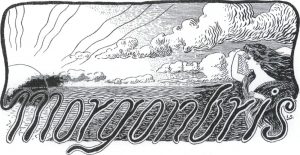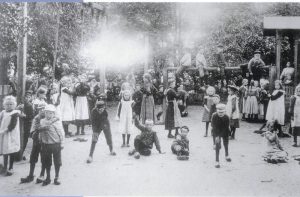Maria Sandel (1870-1927) was a remarkable, if odd, author who published six literary works during the first three decades of the twentieth century. A deaf seamstress, she wrote in a supportive housing home in the Kungsholmen district of Stockholm.
As a feminist, an active Social Democrat, and a favourite among Ellen Key’s circle, she has been referred to as the Fredrika Bremer of the proletariat. She was also a proud recluse, “among the strangest people who have ever held a pen in their hand, and one of the most exasperating authors that a publisher has had to deal with,” according to one of the many descriptions that have come down about her.
“She is hopelessly deaf. She has lived in abject poverty all her life. She machine knits woollen clothes; she and her mother (who is also deaf as a post) own a little shop where the customers weigh the items themselves or point to what they want. The poor woman, around 30 years old at this point, is imprisoned in the gloomiest imaginable existence. She attended elementary school until the age of 12. She lived in America for four years before she lost her hearing. She studied a bit at the worker’s library. She learned enough English in America to read both Burns and Byron. She has also taught herself a little French and German, and reads quite a bit in these languages. She writes and expresses herself with cultivation and charm. What do you have to say about that? I must do something for her, but what? Even if I could scrape together a little cash, what good would it do? Be that as it may, I intend to correspond with her, read her poetry, take her to museums and parks in the spring.”
(Letter from Amalia Fahlstedt to Ellen Key, 30 March 1901)

For twenty-five years, she occupied a little room with a tiled stove in Skogshyddan (Forest Hut), as the supportive housing area was popularly referred to. The barracks had been built around the turn of the century to provide some of the poorest and most disadvantaged families in Stockholm with a roof over their heads. Women assumed total responsibility for the household and children; their husbands drank themselves to death or did all they could to flee their financial obligations. The only way for women to support themselves and their children was to clean middle-class residences or work at home – knitting quilts and hosiery, sewing caps, and other clothing for modest pay. The desperation of their circumstances is succinctly conveyed by the title of her first book, Vid svältgränsen (1908; The Edge of Starvation), a collection of short stories.
Life in Skogshyddan served as a rich source of material. Sandel was a Swedish pioneer when it came to writing about overcrowding, the struggle to put bread on the table, the need for women to work two or three times as hard as men. But her goal was much more ambitious than mere social realism. She cloaked her ethical commitment in literary garb. Feminism was part of her project; she wanted to “correct men’s perception of women”, make them realise that their wives were not only “sex objects” but companions. Her aspiration was to offer moral examples, to create an ideal of feminine cultivation that subjugated wanton impulses to the dictates of reason and pride.
The emphasis on ethics was not unique to Sandel; it was common in the literature of the time. Like many others, she drew inspiration from Charles Dickens’s novels about the slums of London. As was the case with other contemporary proletarian authors, her thinking was shaped by the labour movement’s goal of “raising up the working class.”
The idea of the gigantic project was that rescuing workers from hunger, substandard housing, and ruthless exploitation in the factories was not enough. Leaving behind the uncultivated life, governed by ‘base’ instincts and lack of education, was just as important.
Vid Svältgränsen, Familjen Vinge (1913; The Vinge Family), and Virveln (1913; The Vortex), her first three books, proceed from a social perspective and a clear sense of ethics. The tales are social melodramas that revolve around the threats that women face in the big city. The perils are largely sexual. Not only the factories, but the streets and recreational areas are suffused by the “plague-smitten spirit” of unbridled capitalism, crying out for “every ounce of moral edification at our disposal.” The agents of depravity were the wretches who enticed young women into prostitution and unwanted pregnancy. The female characters who abandoned themselves to love were left in the lurch as well. Prostitution had turned sex into a commodity and men into heartless thieves of women’s emotions. They took what they wanted, disappeared, and left the dishonoured women to their fate.
Sandel presents the warmth of hearth and home as the antidote to the dog-eat-dog life of the streets. She rarely portrays nuclear families, but rather neighbourhood or women’s collectives whose members span several generations. Gerda Spant, a pregnant and destitute factory worker, finds such a home with gruff Mrs Hägg in Droppar i folkhavet (1924; Drops in the People). Needless to say, the home is also threatened by moral turpitude, negligence, and indolence, men who spend all their money on alcohol and abuse their wives and children. But when a strong woman takes control, togetherness, solidarity, solicitude, and other ‘feminine values’ can reign.

A nurturing home is based on the traditional female virtues of diligence, integrity, and abstinence. Protecting them allows women to create a mental sanctuary. But the demands of Eros remain a problem; those who have learned to “think freely and elegantly about sexual relationships” will always have trouble taming their “hot blood”. Sandel’s ‘successful’ female characters are proud and melancholy, their honour intact.
Her narrative temperament alternates, taking her perspective with it: she can suddenly shift from spirited humour to dark, pessimistic rectitude or feminist social inquiry. As her writing matured, it moved from political analysis to a profounder moralism, which shines through more clearly in Hexdansen (1919; The Witch’s Dance) and Mannen som reste sig (1927; The Man Who Rose Again) than in any of her other works. Nevertheless, the dichotomy pervades all of her writing.
This incompleteness or unevenness, her inability to find an authoritative narrative voice, reveals her deeper conflicts about female sexuality. The unresolved problems of form reflect a fundamental dilemma that arises when traditional female values, the beacons of her moral project, clash with modern hedonism and the right to self-determination.
Ellen Key’s view of love, which heavily influenced the feminists of her day, serves as an important ideological backdrop. While arguing that female sexuality should be acknowledged and portrayed, she insisted that it be expressed within a loving relationship to prevent “primitive promiscuity” from taking over.
The depiction of female sexuality in Sandel’s books can be interpreted as variations on Key’s themes. Time and again, she tries in vain to reconcile the conflicting demands of her ideology, a failure that strikes the present-day reader as totally logical. How can you recognise and describe the power of sexuality in women’s lives while recommending abstinence until Mr Right shows up without contradicting yourself?
The young women in Virveln are either high-principled, snooty virgins representing discipline, cultivation, and class consciousness, or careless, impressionable daredevils who pay more attention to pleasure and ostentation than their honour. When the madcap Magda Mejsel learns about sex from her co-workers at the chocolate factory, she is assaulted “by a swarm of impressions – longing, dread, arousal, repugnance – as the images paraded before her insatiable inner eye.” It does not take long for her to ‘give in’ to her impulses, which leads to her inevitable undoing. The stuck-up Birgit Sänke, on the other hand, adopts an intellectual attitude to her sexuality, decides to ‘wait’ and represents more of an ideal. But Sandel isn’t fully invested in her moral project. Her adventurers manifest a lot more substance, life, and energy than her ideal figures. She is so fascinated by the ‘wild’ women who partake freely of life’s ‘goodies’ that the reader is soon swept along as well. Although she injects a disclaimer now and then, the plot speaks another language.
Even her portrayal of Ulla, a slattern of almost mythological proportions, in Mannen som reste sig is captivating precisely because it so strongly evokes the forbidden side of femininity. Ulla can’t sew on a button or sweep a floor; she is cheeky, profligate, and easily seduced. She neglects her sick mother-in-law, embroils her husband in alcoholism, and abandons her children. This modern Lilith is a lot more fun to read about than Eva, the paragon of virtue who ultimately takes Ulla’s place as wife and mother; Sandel’s moral admonishments do little to take the sheen off her fascination.
“Loops in her buttonholes due to overconsumption of pastries, tattered garters, missing buttons, bursting seams, hairpins falling out… So what? If her hair fell down, she twisted it back up again, be it in the middle of the street, and men weren’t the least bit displeased, for her sparkling countenance sent a ray of sunshine and the premonition of spring quivering through their bodies. But women found her repulsive down to the soles of their feet …
“Everything she undertook was performed carelessly or left half undone. If she sewed on a button, it dangled from its thread, which she had forgotten to knot; if she swept the floor, half of the dirt never made it to the dustpan… Too lazy to keep track of household items, Ulla supplied the sanitation department with knives, forks, and anything else that might end up in a refuse bin, squandered her possessions, and stood passively by as her world fell apart.”
(Mannen som reste sig)
Translated by Ken Schubert

